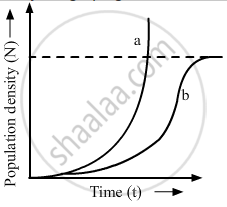Advertisements
Advertisements
Question
Give an account of population regulation.
Solution
The inherent tendency of all animal populations is to increase in number. But it does not increase indefinitely. Once the carrying capacity of the environment is reached, population numbers remain static or fluctuate depending on environmental conditions. This is regulated by many factors which are
- Density independent – Extrinsic factors
- Density-dependent – Intrinsic factors
Extrinsic factors include the availability of space, shelter, weather, and food, etc. Intrinsic factors include competition, predation, emigration, immigration, and diseases.
APPEARS IN
RELATED QUESTIONS
(a) Name the two growth models that represent population growth and draw the respective growth curves they represent.
(b) State the basics for the difference in the shape of these curves
(c) Which one of the curves represents the human population growth at present? Do you think such a curve is sustainable? Give reason in support of your answer.
Study the graph given below and answer the questions that follow :

(i) Write the status of food and space in the curves (a) and (b).
(ii) In the absence of predators, which one of the two curves would appropriately depict the prey population?
(iii) Time has been shown on X-axis and there is a parallel dotted line above it. Give the significance of this dotted line
Define the Carrying capacity.
What is reproductive fitness? Explain it with the help of an example.
Animals that can move from fresh water to sea called as ________.
The phenomenal and rapid increase of population in a short period is called ______.
`"dN"/"dt" = "rN" (("K"- "N")/"K")` in logistic growth "K" represents:
The density of a population in a habitat per unit area is measured in different units. Write the unit of measurement against the following:
Banyan
List any four characters that are employed in human population census.

Identify the type of pyramid given above. Write the identifying feature on the basis of which you identified it.
